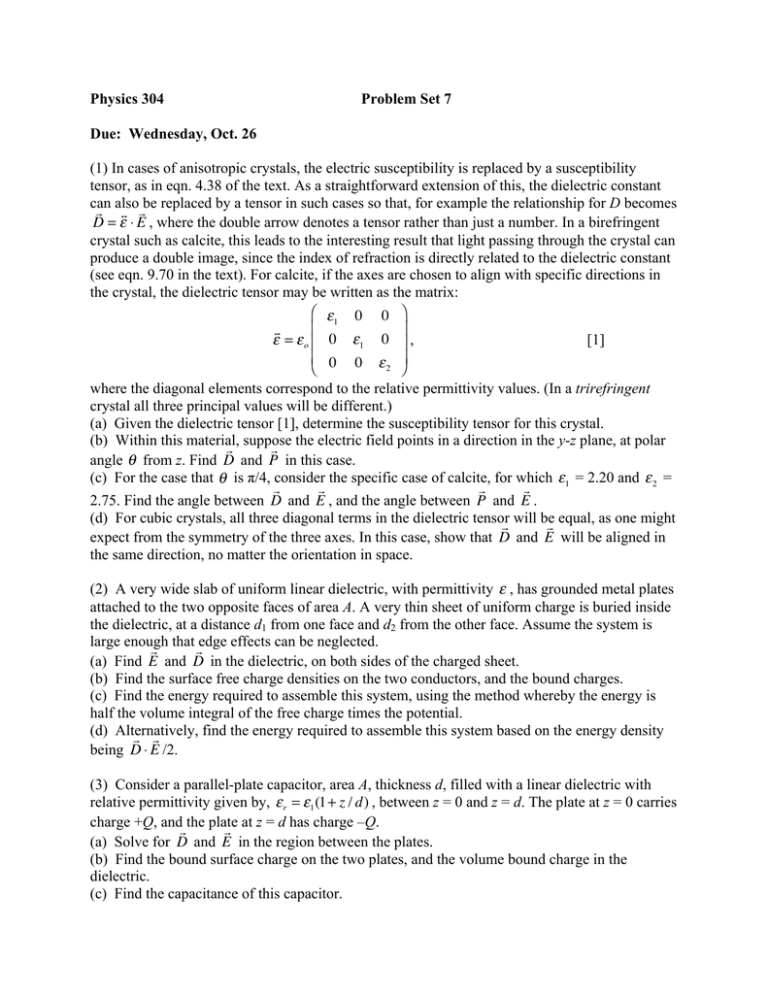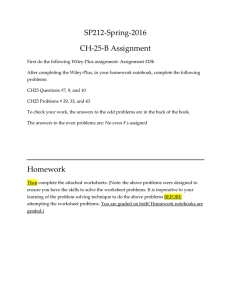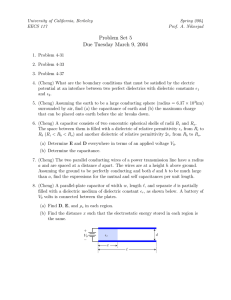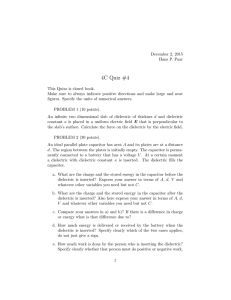Physics 304 Problem Set 7 Due: Wednesday, Oct. 26
advertisement

Physics 304 Problem Set 7 Due: Wednesday, Oct. 26 (1) In cases of anisotropic crystals, the electric susceptibility is replaced by a susceptibility tensor, as in eqn. 4.38 of the text. As a straightforward extension of this, the dielectric constant can be replaced by a tensor in such cases so that, for example the relationship for D becomes ! also " ! D = ! " E , where the double arrow denotes a tensor rather than just a number. In a birefringent crystal such as calcite, this leads to the interesting result that light passing through the crystal can produce a double image, since the index of refraction is directly related to the dielectric constant (see eqn. 9.70 in the text). For calcite, if the axes are chosen to align with specific directions in the crystal, the dielectric tensor may be written as the matrix: " !1 0 0 % ! $ ' [1] ! = ! o $ 0 !1 0 ' , $ 0 0 ! ' 2 & # where the diagonal elements correspond to the relative permittivity values. (In a trirefringent crystal all three principal values will be different.) (a) Given the dielectric tensor [1], determine the susceptibility tensor for this crystal. (b) Within this material, ! suppose ! the electric field points in a direction in the y-z plane, at polar angle ! from z. Find D and P in this case. (c) For the case that ! is π/4, consider the specific case of calcite, for which !1 = 2.20 and ! 2 = ! ! ! ! 2.75. Find the angle between D and E , and the angle between P and E . (d) For cubic crystals, all three diagonal terms in the dielectric tensor! will be ! equal, as one might expect from the symmetry of the three axes. In this case, show that D and E will be aligned in the same direction, no matter the orientation in space. (2) A very wide slab of uniform linear dielectric, with permittivity ! , has grounded metal plates attached to the two opposite faces of area A. A very thin sheet of uniform charge is buried inside the dielectric, at a distance d1 from one face and d2 from the other face. Assume the system is large enough ! that !edge effects can be neglected. (a) Find E and D in the dielectric, on both sides of the charged sheet. (b) Find the surface free charge densities on the two conductors, and the bound charges. (c) Find the energy required to assemble this system, using the method whereby the energy is half the volume integral of the free charge times the potential. (d) Alternatively, find the energy required to assemble this system based on the energy density ! ! being D ! E /2. (3) Consider a parallel-plate capacitor, area A, thickness d, filled with a linear dielectric with relative permittivity given by, ! r = !1 (1 + z / d) , between z = 0 and z = d. The plate at z = 0 carries charge +Q, and! the plate ! at z = d has charge –Q. (a) Solve for D and E in the region between the plates. (b) Find the bound surface charge on the two plates, and the volume bound charge in the dielectric. (c) Find the capacitance of this capacitor. (4) Griffiths problem 4.24, page 190. (5) Griffiths problem 4.36, page 199. (6) The setup for this problem is similar to the last problem in homework 4, except that the inserted slab is a linear dielectric of relative dielectric constant ! r . A parallel plate capacitor is shown, where the dielectric slab is allowed to slide horizontally into the capacitor. The capacitor plate separation is d, and the rectangular plates have dimensions a × b. When the dielectric extends in by a distance x, it occupies an area x × a, and the gap above it is d/2. The slab can slide just above the bottom plate, so that the narrow gap below has negligible thickness. Also neglect edge effects both at the capacitor edge and at the edge of the dielectric, assuming that the E field is locally uniform and vertical everywhere. (a) With fixed charge Q on the plates, note that the charge densities on the surfaces in the different regions will be different, but ∆V from plate to plate is the same. There are three E fields to determine: the field in the region on the left, the field above the dielectric, and the field in the dielectric. In terms of the unknown ∆V, solve for the E fields, and then the surface charges on the metal plates in the two regions. Find the total free charge = Q, and then determine the capacitance vs. x. (b) Find the total energy of this configuration in terms of Q and the system dimensions (several methods are possible). (c) Find the horizontal force on the dielectric by using the gradient of the potential method. Will it be pulled into the gap or pushed out?


